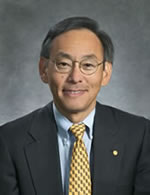
About "A View to the Future"

When I first arrived at Berkeley Lab as its Director in August of 2004, I knew of this Laboratory’s distinguished history — its nine Nobel Prizes, the pioneering “team science” created by founder Ernest Lawrence. We have a legacy of seminal contributions in the fields of high energy and nuclear physics, chemistry, accelerator science and, in more recent times, energy efficiency, advanced computing, materials, and the biosciences. I inherited an outstanding lab from my predecessor, Chuck Shank.
I knew that LBNL was a special place, but I did not know how special until I began to attend division reviews, Laboratory Directed Research and Development meetings, and began to work closely with the talented staff on the science and operations sides of the house. It became apparent to me why Berkeley Lab is regarded by the DOE as a national treasure.
Soon after I arrived, I became embroiled in the contract competition for continued management of Berkeley Lab by the University of California. Working with UC in its bid to retain the contract with the Department of Energy, our senior management team began to realize the exciting opportunities available because of the extraordinary resources of our Lab: the scientists and supporting staff, the national facilities, and the close proximity of UC Berkeley and UCSF.
In order to capture the full potential of these opportunities, we have formed alliances among the Lab’s centers of excellence to attack various scientific and technological challenges. There are many outstanding examples of interdisciplinary work being done at the Lab that bring together areas in the biological sciences, the physical sciences, and the computational sciences. Many of these areas are outlined in the body of this report.
When I worked at Bell Laboratories, we were immersed in a culture of interdisciplinary problem-solving where research partnerships formed spontaneously over lunch in the cafeteria, after seminars, and in social events. While at Stanford, I wanted to duplicate this atmosphere and helped start Bio-X, the largest interdisciplinary initiative on campus, with several hundreds of millions of dollars of University support. Following Dr. Lawrence’s collaborative approach to science, I see that a major part of my job is to make our collaborative environment even better.
A new Lab-wide initiative is starting to develop sustainable, CO2– neutral sources of energy that will draw upon many of the core strengths of the Berkeley Lab. While energy efficiency will play a huge role in defining how much energy we will need, we must also have a diversified portfolio of investments in energy sources. Among America’s most serious concerns are national security (intimately tied to energy security), long-term economic competitiveness, and the dangers of global warming. The need for CO2– neutral energy is central to all of these concerns, and thus is the single most important societal problem that science and technology must solve.
There appear to be no magic bullets to solve this problem. Already, we are contributing to fusion research, the waste storage problems associated with fusion energy, and carbon sequestration of the combustion products of fossil fuel. Answers may also lie in greatly improved photovoltaic generation, efficient methods to convert electricity into chemical energy, and synthetic mimics of photosynthesis. Another promising avenue is to apply advances in molecular biology to develop faster-growing, self-fertilizing plants and more efficient methods to convert biomass (including biowaste) into more useful forms of energy.
Berkeley Lab is uniquely positioned to tackle this challenge, with its strengths in the biological, chemical and computational sciences; world-class facilities like the Advanced Light Source, the National Center for Electron Microscopy, NERSC, the Molecular Foundry; its distinguished corps of engineers; and its leadership in material science and nanotechnology. This is collectively a prodigious scientific resource, and we are capable of attacking this problem in a way reminiscent of Bell Laboratory’s development of a solid state electronic switch (the transistor) to replace the vacuum tube.
There are more examples of interdisciplinary work that can be done at our Lab. In this Berkeley Lab Report, our scientific directions are summarized and our core competencies are described. Including goals for the next five years in six different areas, the Report is designed to help those who may not fully understand our work to appreciate the value that LBNL can continue to bring to our world. It is also my hope that those responsible for investing in scientific research in this country can learn about what we do and how we are impacting science, society and our future generations.
The knowledge we acquire in science is additive, and at its core is our ability to be stimulated by others. Through our collective efforts, we will do far more than we can separately. By creating a fertile, supporting environment of creativity and innovation, we will accomplish great things as we prepare to celebrate Lawrence Berkeley National Laboratory’s 75th year of service.
Steve Chu
Director